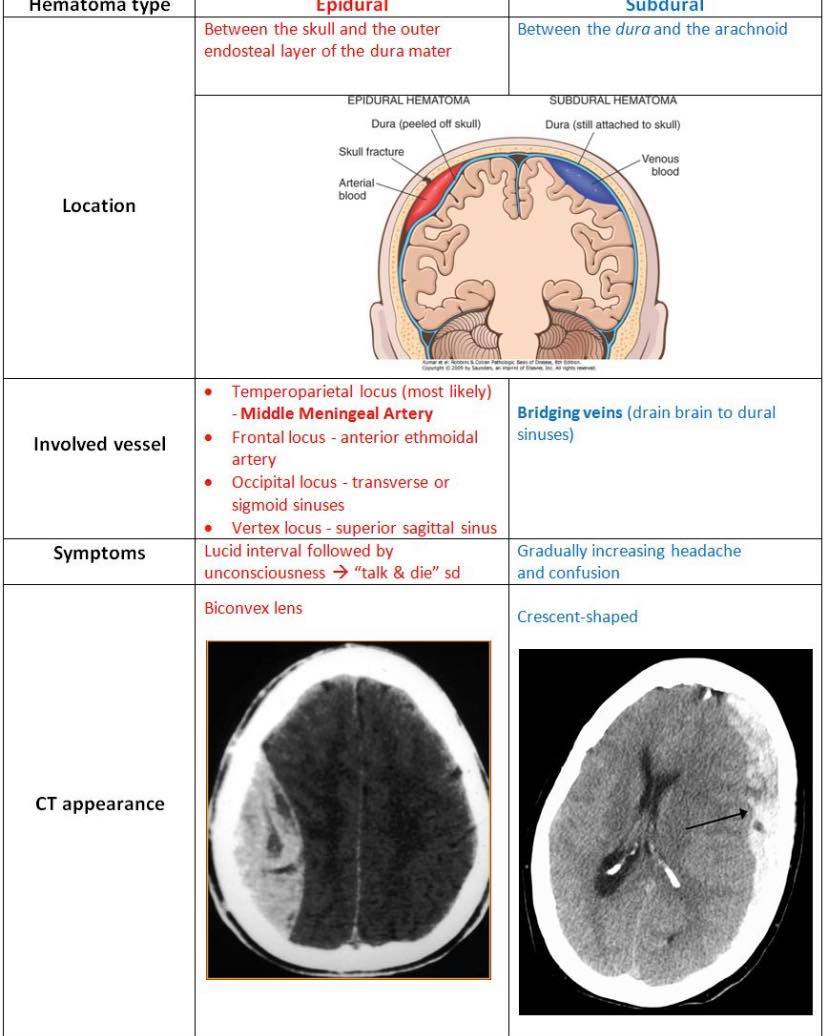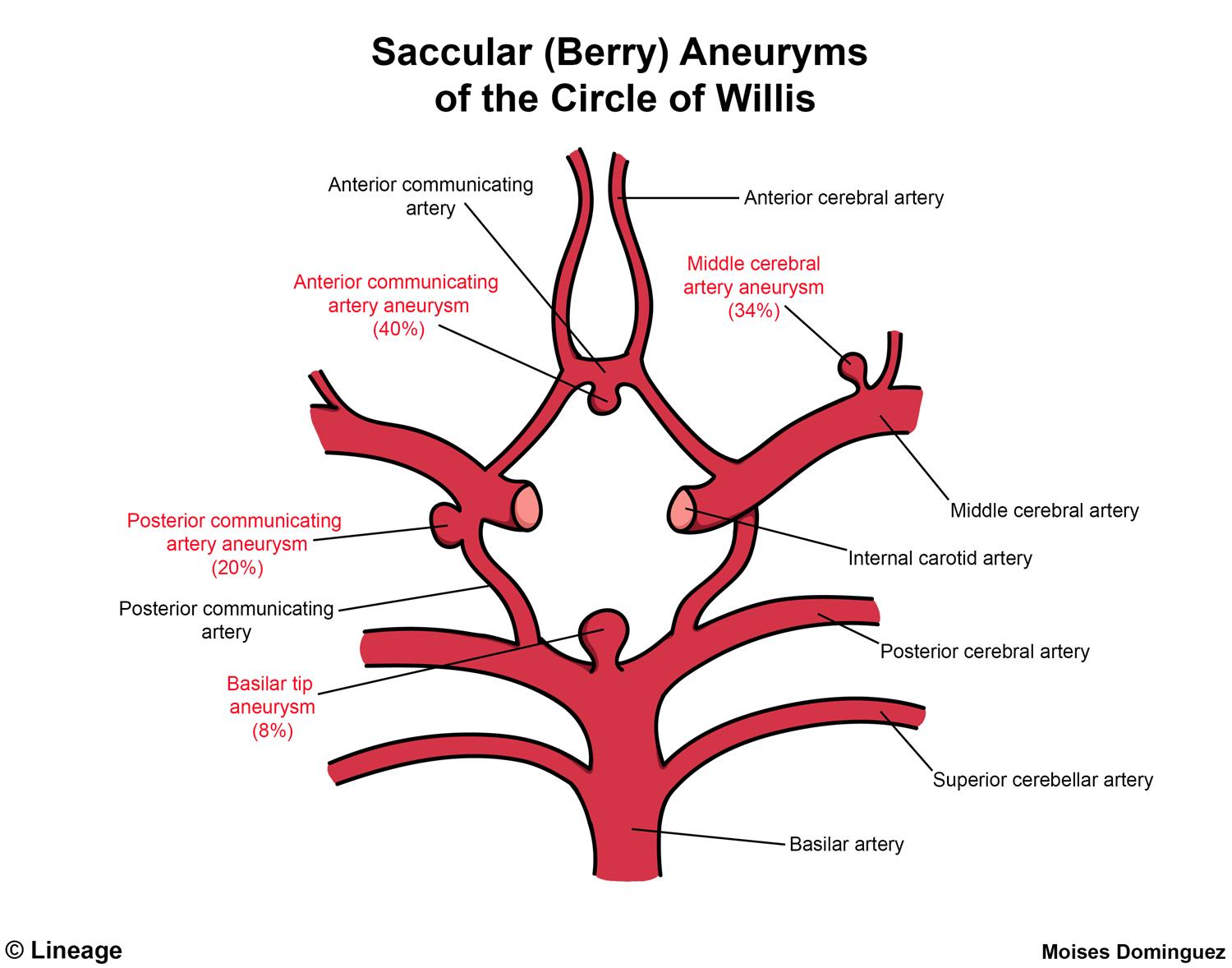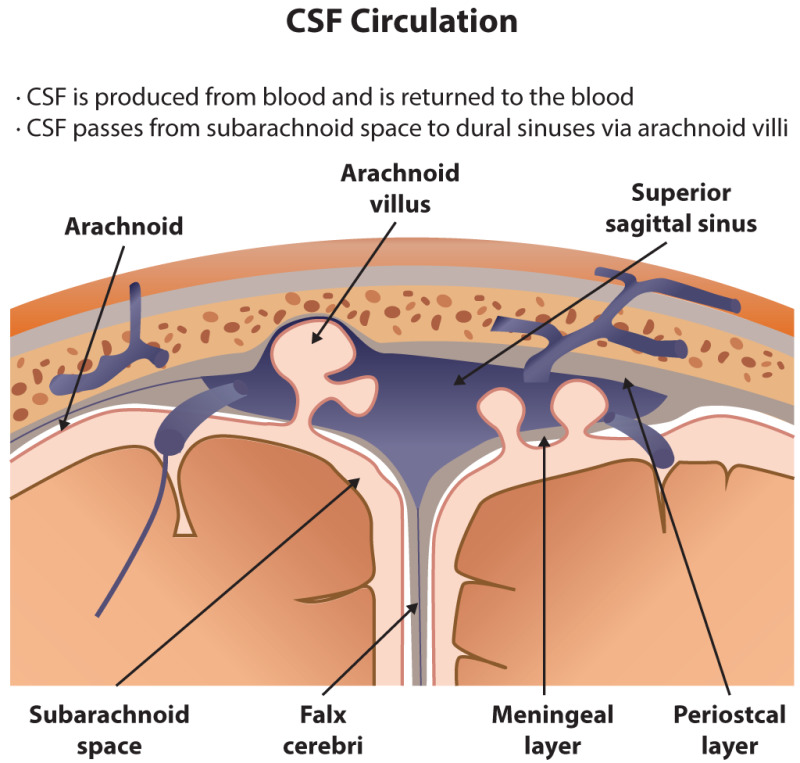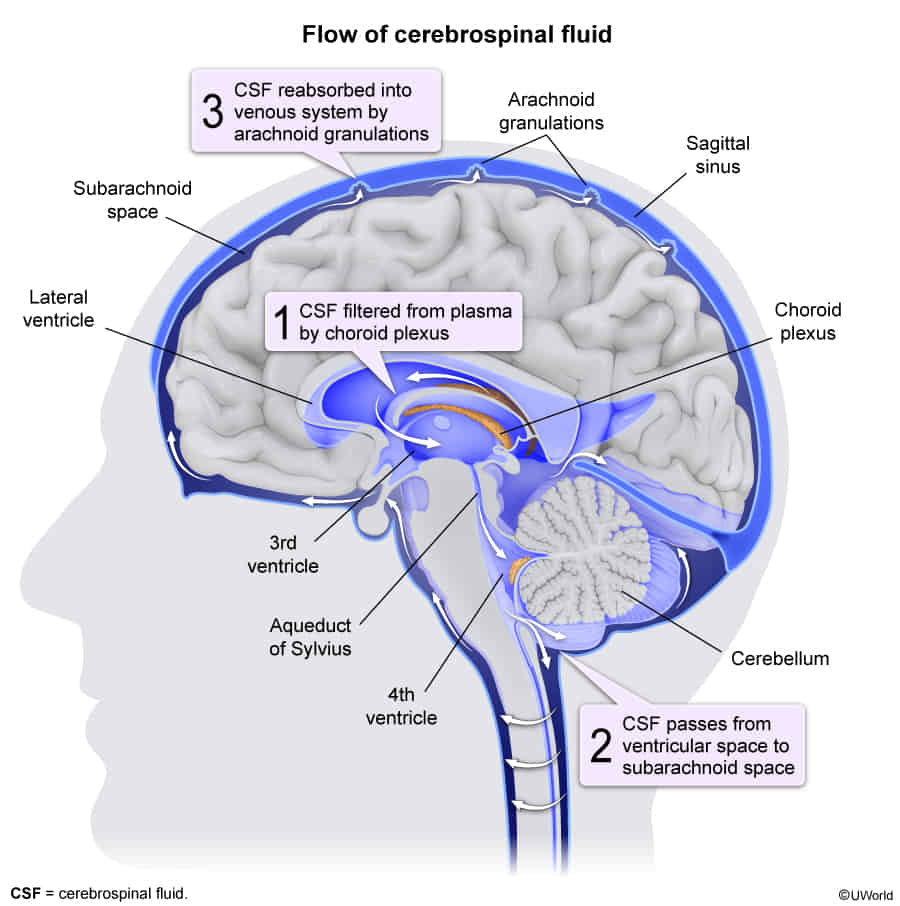| Feature | Epidural Hematoma (EDH) | Subdural Hematoma (SDH) | Subarachnoid Hemorrhage (SAH) | Intracerebral Hemorrhage (ICH) |
|---|---|---|---|---|
| Location | Potential space between dura and skull. | Between dura and arachnoid mater. | Between arachnoid and pia mater (in CSF space). | Within the brain parenchyma itself. |
| Vessel | Middle Meningeal Artery (arterial bleed). | Bridging Veins (venous bleed). | Cerebral Arteries (often from ruptured saccular/berry aneurysm). | Lenticulostriate arteries, Charcot-Bouchard microaneurysms. |
| Cause | Trauma (esp. temporal bone fracture at the pterion). | Trauma (acceleration-deceleration). Can be acute or chronic. | Ruptured aneurysm (most common non-traumatic), trauma. | Hypertension (most common), amyloid angiopathy, AVM, tumor, trauma. |
| Patient | Young adult, head trauma (e.g., MVC, baseball injury). | Elderly, alcoholics, shaken babies (due to brain atrophy stretching veins). | Aneurysm rupture often in 40s-60s. Associated w/ PKD, Ehlers-Danlos. | Older patients with chronic HTN. |
| Presentation | ”Lucid interval” followed by rapid decline, signs of ↑ ICP (headache, N/V, CN III palsy). | Varies widely. Acute: ↓ consciousness. Chronic: gradual cognitive decline, focal deficits, headache. | ”Worst headache of my life” (thunderclap headache, sudden blood leakage into CSF irritates meninges), nuchal rigidity, photophobia, no focal deficits initially. | Abrupt onset of focal neurological deficits (e.g., hemiparesis, aphasia), headache, seizure, N/V. |
| Head CT | Biconvex (lens-shaped) hyperdensity. Does NOT cross suture lines. | Crescent-shaped hyperdensity. CAN cross suture lines. | Hyperdensity in sulci, cisterns, and fissures. | Hyperdense mass within the brain tissue. Common in basal ganglia, thalamus, pons, cerebellum. |
| Management | Emergent neurosurgical evacuation (craniotomy). | Surgical evacuation if large or symptomatic. | Supportive care, nimodipine (prevents vasospasm), coiling/clipping of aneurysm. | BP control (aggressive reduction), reverse anticoagulation, manage ICP; surgery in select cases. |
| Key Buzzword | Lucid interval, lentiform. | Crescent-shaped, bridging veins. | Worst headache of my life, thunderclap, berry aneurysm. | Hypertensive bleed, Charcot-Bouchard. |

Epidural hematoma
Subarachnoid hemorrhage
Etiology
- Elderly individuals experience age-related cerebral atrophy. This brain shrinkage puts increased tension on the bridging veins, making them highly susceptible to tearing from shearing forces, even with relatively minor head trauma (like a fall).
- Traumatic SAH: traumatic brain injury
- Nontraumatic (spontaneous) SAH
- Ruptured intracranial aneurysms
- Most commonly occur in the circle of Willis
- Berry aneurysms account for approx. 80% of cases of nontraumatic SAH.
- Also known as Saccular aneurysm because of the shape

- Round, saccular shape
- Most common type of cerebral aneurysm
- Typically occur at vessel junctions in the circle of Willis, most commonly between the anterior communicating artery and anterior cerebral artery
- Account for ∼ 80% of cases of nontraumatic subarachnoid hemorrhage
- Also known as Saccular aneurysm because of the shape
- Ruptured arteriovenous malformations (AVM)
- Ruptured intracranial aneurysms
Charcot-Bouchard aneurysms vs Saccular (berry) aneurysms
Feature Charcot-Bouchard Microaneurysms Saccular (Berry) Aneurysms Associated Conditions Hypertension ADPKD, Ehlers-Danlos syndrome, hypertension Location Basal ganglia
Cerebellum
Thalamus
PonsCircle of Willis Size <1 mm Variable, 2-25 mm Result of Rupture Intracerebral hemorrhage Subarachnoid hemorrhage Symptoms of Rupture Progressive neurologic deficits
Headache may followSudden severe headache
Focal neurologic deficits uncommon
-aneurysms/../../../appendix/Pasted-image-20250304102040.png)
Link to original
- Saccular: This term means “resembling a sac.” Saccular aneurysms are outpouchings or bulges on one side of a blood vessel wall.
- Berry: The “berry” description refers to the characteristic round shape of these aneurysms. They look like a berry connected to the main artery.
Clinical Features
- Gradual/Insidious Onset: Neurologic decline over hours to days.
- Sx: Headache, somnolence, confusion, light-headedness, focal neurologic deficits (e.g., focal weakness).
- Chronic SDH (weeks to months old): Can present with subtle cognitive impairment, dementia-like symptoms, and gait disturbances, particularly in the elderly.
Diagnosis
CT head without contrast
- Defining feature: blood in subarachnoid space (hyperdense) with variable extension and location


Treatment
Initial management
- Prevention of rebleeding
- Anticoagulant reversal
- Management of blood pressure and cerebral perfusion pressure
- Target SBP < 160 mm Hg
- Other neuroprotective measures
- Start ICP management (e.g., elevate head 30°, IV mannitol, short-term controlled hyperventilation).
Treatment of aneurysmal SAH
- Intracranial aneurysm repair
- Endovascular coiling
- Microsurgical clipping
- Prevention of vasospasm and delayed cerebral ischemia
- Administer oral nimodipine
- Only administer nimodipine orally or via enteral tube; Parenteral administration is associated with significant adverse effects (e.g., severe hypotension and cardiac arrest).
- Treatment of hydrocephalus: may include an external ventricular drain (EVD), lumbar drainage, or permanent ventriculoperitoneal shunt
- Administer oral nimodipine
Warning
Generally avoid nitrates for blood pressure control in brain injury, as they may elevate ICP. Consider alternative agents (e.g., titratable nicardipine or labetalol).
Complications
Vasospasm
- Occurs in approx. 30% of patients with SAH
- Pathophysiology
- Impaired CSF reabsorption from the arachnoid villi → nonobstructive (communicating) hydrocephalus → ↑ intracranial pressure → ↓ cerebral perfusion pressure → ischemia

- Release of clotting factors and vasoactive substances → diffuse vasospasm of cerebral vessels → ischemia
- Impaired CSF reabsorption from the arachnoid villi → nonobstructive (communicating) hydrocephalus → ↑ intracranial pressure → ↓ cerebral perfusion pressure → ischemia
- Can lead to ischemic stroke
- Most common in patients with nontraumatic SAH due to a ruptured aneurysm
- Usually occurs between 3–10 days after SAH
- Oral nimodipine should be given after subarachnoid hemorrhage to prevent vasospasm
-aneurysms/../../../appendix/Pasted-image-20240526113641.png)